Cleaning and Preservation of Coins - A Complete Guide, page 17
HOW TO CLEAN COPPER and BRONZE COINS: Various Effective Methods and Applications
The following methods can be used for cleaning copper coins:
1) Cleaning with Soft Erasers, a Toothpick, a Bone Stylus, and Ink eraser for large amounts of the coating, which can be sandy, clayey, saline or greasy. Please see an example of treatment of a bronze Indian Head penny with a toothpick on page 8.
2) Cleaning with Brushes (see details on page 6).
3) Wet Cleaning (see details on page 10).
4) Cleaning with Carpenter's Glue: this method is used for dirt and false patina (see page 10).
5) Cleaning with Vitrinol Copper Soap (available in drugstores): the soap is applied with a moist cloth used to rub the coin.
6) Immersion into a Hydrogen Peroxide (H2O2) bath (described on page 11) is applied briefly to remove the dirt.
Sweden 17th Century Dug Copper Coin Before Cleaning in Hydrogen Peroxide
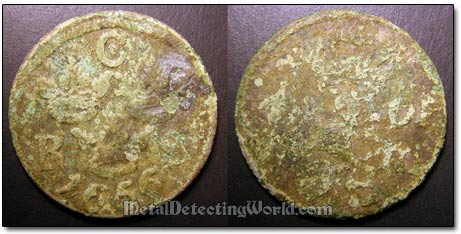
1666 1/6 Ore Swedish Coin After Being in Hydrogen Peroxide Bath for One Hour and Then Patinated

7) Copper Scale Removal: dull orange-red changes (Cu2O, cuprous oxide) and black coatings (CuO, cupric oxide) are caused by annealing of the copper coins, and have destroyed at least the coin's surface and sometimes even the whole coin.
Copper scale is removed by putting the coin in dilute Sulfuric acid (5% to 10%) for no longer than 10 minutes. The coins are then washed under the faucet and rubbed energetically with a copper cleaner - Vitrolin copper cleaning soap.
The coins are then neutralized for a short time in very dilute Sodium Hydroxide (caution: caustic soda) and are rinsed.
The copper coins, if not too severely oxidized, appear as fresh as if they had just come from the mint. They can be darkened if desired, as described on pages 22 and 23, thereby receiving a completely natural appearance without any evidence of having been in a fire.
8) Boiling: the copper coins also can be boiled ten minutes in solution of Baking Soda and water.
9) Removing Verdigris: verdigris is most easily removed by rubbing with a moist cloth which has been passed over copper soap.
10) Immersion into 10% Ammonia (NH4OH) Solution Bath (described on page 13): the coins should be immersed for a few minutes or continually taken out, soaked with several changes of water and brushed. Great care must be exercised here as the coins might be damaged if they are exposed to the air for a long moment while being transferred from the ammonia bath to the acid bath. A brief immersion in a 5% hydrochloric acid for neutralization should follow immediately.
Here is the case of dug copper coin that was immersed into Ammonia solution for a few hours and then patinated.
The Copper Coin Before Immersion
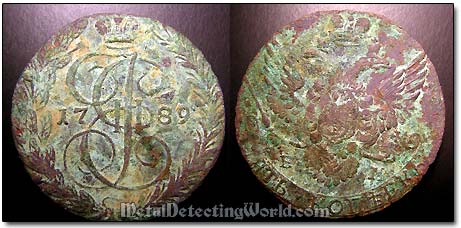
The Same Coin After Cleaning and Patination
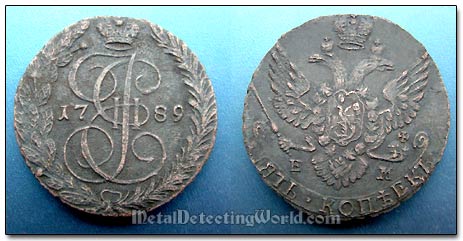
If dark spots remain under the previous verdigris, they are simply left there, because copper retarnishes very quickly. The coins then of course can be brightened (described on page 21), tarnished (described on page 22) or artificially patinated (see details on page 23) over the entire surface, or on parts of the surface by using a Q-Tip.
11) Immersion into Hydrochloric Acid (HCl) or dilute Nitric (HNO3) acid: great care must be exercised here as well. The coins are removed frequently at first and at longer intervals after it has been possible to judge the effect.
Base metals such as copper should be neutralized after acid treatment by a single short immersion in Sodium Hydroxide (NaOH) (caution: caustic lime) or in Ammonia solution.
NOTE: COPPER COINS MAY NOT BE TREATED WITH SULFURIC ACID (except for a brief immersion during the hard copper scale removal)!
12) Removing False Patina: copper, bronze and brass coins coated with false patina (not to be confused with ARTIFICIAL PATINA - see "Artificial Patination of Coins" page 23 for details) must be tested with the greatest possible care to discover whether the "false patina" is actually involved. If this is certain, then the next question is whether it is possible that the coins, freed of coating, will be found in better condition than with coating.
If it is decided to remove the false patina, the following methods described above can be applied: method 3 (treatment with 000 steel wool can then follow), method 4, method 5, method 7 and method 10 (with 5% Hydrochloric acid; the coins are then rinsed and scrubbed with a hard brush, and soaked for a half hour with frequent changes of water).
The following pictures depict the copper coin that underwent the treatment for removal of the false patina.
Bad Case of False Patina Encrustation - "Bronze Disease"
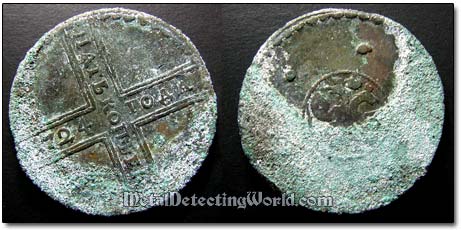
After Being Immersed Into Ammonia Solution for One Day
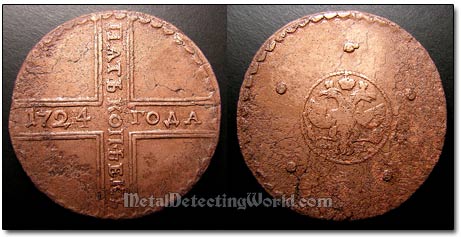
Russian 1724 5 Kopeks After Being Cleaned and Patinated

As you can see, this cleaning method removes the original coin's patina and strips the coin to bare metal. If you wish to keep the coin's true patina, please use the patina-saving method for curing the "Bronze Disease" on copper-base alloyed coins, which is described on page 3.
13) Electrochemical Reduction with Zinc and Sodium Hydroxide (Caustic Soda): the Electrochemical Reduction method is described on page 15 and can be done with other metals and liquids too according to the electromotive series (see a table on page 15). However, ancient coperous coins must NOT be subjected to any of electrochemical or electrolytic reduction cleaning techniques. After a lengthy rinsing, in this case a day-long soaking in hot water renewed several times, and finally drying at 212 °F (100 °C) should follow. The coins are then cleaned of dust by a blower.
You may want to learn a Simplified and Quick Method for Cleaning Copper Coins and Enhancing Their Designs' Appearance.